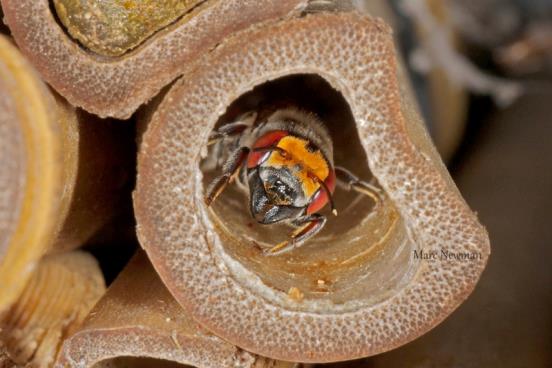Australia is home to over 2,000 species of native bee, but few of these are highly social, colony-forming bees. Over 90% of Australia’s bees are solitary. Once mated, each female becomes a ‘single, working mother’, constructing and provisioning each brood cell without the help of others.

Figure 1. Solitary bee brood cells, with bee bread and larvae. Photo Erica Siegel.
Many of you will be aware of the solitary bees that utilise pre-existing cavities, such as old borer holes, hollow stems, nooks and crannies under bark or in man made “bee hotels”. Cavity nesting bees include leaf cutter, res-in, reed and masked bees. But only 30% of our bees nest in these cavities.

Figure 2. Megachile aurifrons, resin bee, nesting in ‘bee hotel’. Photo Marc Newman.
About 70% of Australia’s bees are ground nesting. The female digs a burrow, usually vertically in horizontal ground, using her mandibles to loosen the grains of soil. As she works her way down the burrow, she pushes soil behind her. Then, she vibrates her body and uses her abdomen to ‘bulldoze’ the soil, up the shaft, to the surface. Some bees form a tumulus (D) to protect the en-trance, others construct tall turrets (B), while others may scatter the soil.

Figure 3. Variety of nest architecture. (A) single brood cell, (B) multiple eggs in one brood cell with a turret entrance (C) complex tunnels (D) complex tunnels with tumulus at en-trance. Photo Antoine & Forrest 2020.
Once the burrow is long enough, which can be anywhere between 1 and 530 cm!! the female excavates side shafts which terminate in a single brood cell. The brood cell is carefully tamped and smoothed with special pygidial plates, on the end of her abdomen. She then applies a waterproof coating, that she secretes from the Dufour’s gland. The coating is thought to help maintain the appropriate humidity needed to keep the provisions and larva healthy. Construction and egg laying within the brood cells vary between species.
While each nest is excavated by individual ‘single mums’, these mums enjoy the company of others and most ground nesting bees develop aggregations of burrows, close by to each other. It is thought this may be a ‘safety in numbers’ behaviour. Aggregations can range from a few dozen to over 300 nests per square metre. And there have even been reports from north America of Calliopsis pugionis forming aggregations of 1,650 nests per square metre.

Once the female bee has created a safe place for her off-spring, she leaves the nest to forage on flowers, collecting pollen (the protein source) and nectar (the carbohydrate), to provision the brood cell. All the while, moving pollen from one flower to another and significantly contributing to the pollination of crop and native plants. In most native bee species, females carry dry pollen on specialised scopal hairs. When she returns to the nest, she unpacks the pollen and kneads in nectar that she has collected and previously dehydrated. She lays an egg on top of the bee bread and painstakingly seals the brood cell with an earthen cap. To ensure the occupant’s safety, she then barricades the capping with more soil. She leaves the nest to repeat the process again. And again… and again, until the day she dies.In her short lifetime, each solitary female bee may produce one or dozens of offspring. Her reproductive success depends on so many things. Predators, of which there are many, available food resources, climate, soil environment, soil disturbance and… us!
Ground nesting bees have never been under as much threat as they are today. Anthropogenic activities, such as housing development, farming, landscaping, roads and even our well-intentioned gardening and planting, dig up the soils that they nest and reproduce in. Ground nesting bees spend most of their lives underground, and because they are mostly unseen, conservation efforts are difficult.
Dr Jordan Kueneman, from Cornell University, and his colleagues, have developed a community science project, to map aggregations of ground nesting bees globally. They are seeking to engage communities, through iNaturalist, which will help identify the bees as well as map their location. This will create new opportunities for their conservation.
So, if you would like to help increase community awareness, contribute to scientific research and help develop conservation strategies for our Australian ground nesting bees, please be a part of the GNBee project. Visit the iNaturalist project here
Megan Halcroft, Bees Business
References
Antoine, C. M. and J. R. K. Forrest (2020). “Nesting habitat of ground-nesting bees: a review.” Ecological Entomology 46: 143-159.
Houston, T. (2018). “A Guide to Native Bees of Australia”. Melbourne, CSIRO, 272p.
Kueneman JG, Dobler CN and Danforth BN (2024) “Harnessing community science to conserve and study ground-nesting bee aggregations.” Front. Ecol. Evol. 11:1347447. doi: 10.3389/fevo.2023.1347447

